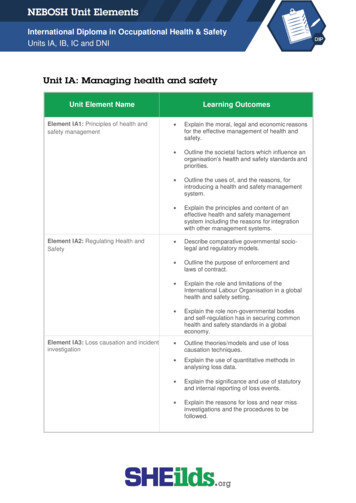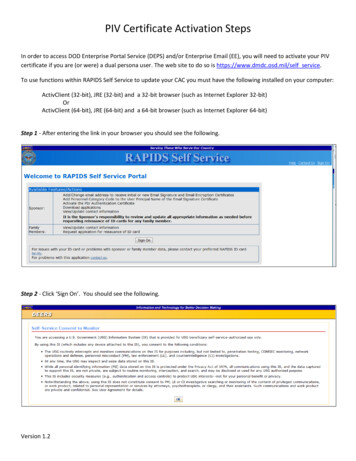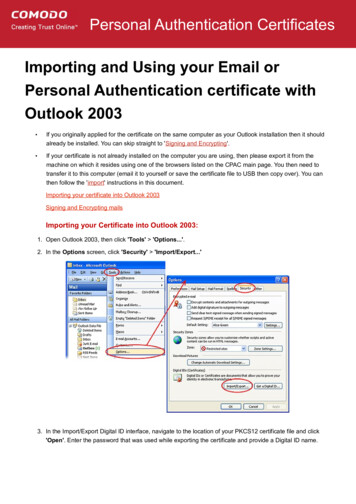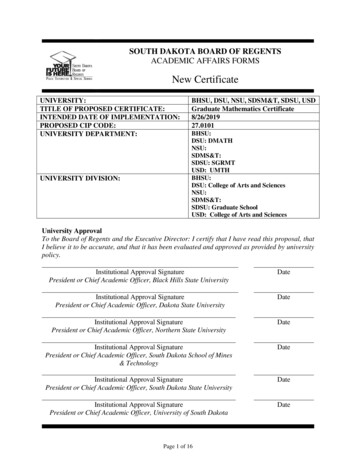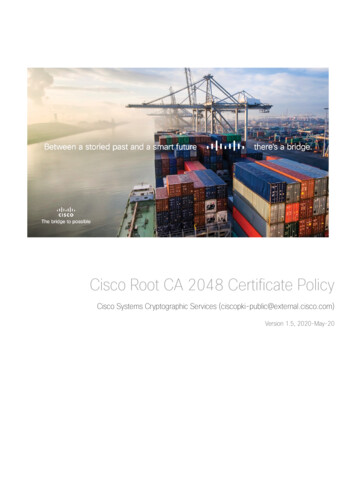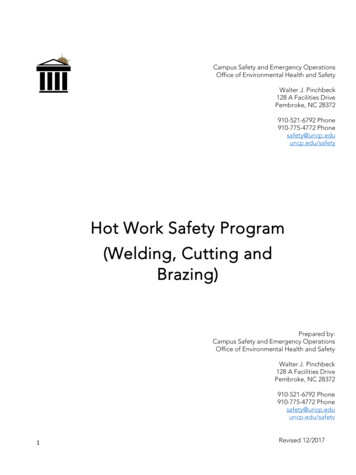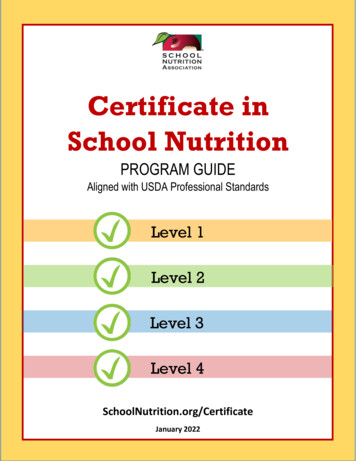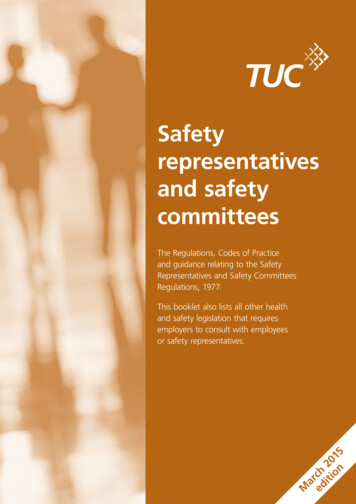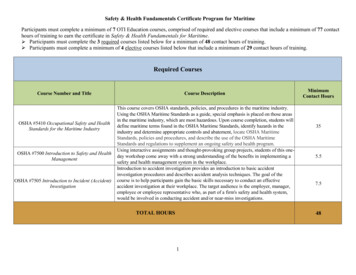
Transcription
Safety & Health Fundamentals Certificate Program for MaritimeParticipants must complete a minimum of 7 OTI Education courses, comprised of required and elective courses that include a minimum of 77 contacthours of training to earn the certificate in Safety & Health Fundamentals for Maritime. Participants must complete the 3 required courses listed below for a minimum of 48 contact hours of training. Participants must complete a minimum of 4 elective courses listed below that include a minimum of 29 contact hours of training.Required CoursesCourse Number and TitleOSHA #5410 Occupational Safety and HealthStandards for the Maritime IndustryOSHA #7500 Introduction to Safety and HealthManagementOSHA #7505 Introduction to Incident (Accident)InvestigationCourse DescriptionThis course covers OSHA standards, policies, and procedures in the maritime industry.Using the OSHA Maritime Standards as a guide, special emphasis is placed on those areasin the maritime industry, which are most hazardous. Upon course completion, students willdefine maritime terms found in the OSHA Maritime Standards, identify hazards in theindustry and determine appropriate controls and abatement, locate OSHA MaritimeStandards, policies and procedures, and describe the use of the OSHA MaritimeStandards and regulations to supplement an ongoing safety and health program.Using interactive assignments and thought-provoking group projects, students of this oneday workshop come away with a strong understanding of the benefits in implementing asafety and health management system in the workplace.Introduction to accident investigation provides an introduction to basic accidentinvestigation procedures and describes accident analysis techniques. The goal of thecourse is to help participants gain the basic skills necessary to conduct an effectiveaccident investigation at their workplace. The target audience is the employer, manager,employee or employee representative who, as part of a firm's safety and health system,would be involved in conducting accident and/or near-miss investigations.TOTAL HOURSMinimumContact Hours355.57.5481
Elective Courses for Maritime IndustryCourseDescriptionCourse Name and TitleThis course covers industrial hygiene practices and related OSHA regulations andprocedures. Course topics include recognition, evaluation, and control of chemical,physical, biological and ergonomic hazards, Permissible Exposure Limits (PEL), OSHAhealth standards, respiratory protection, engineering controls, OSHA sampling protocolsand strategies, and workplace health program elements. The course features workshops inOSHA #521 OSHA Guide to Industrial Hygienehealth hazard recognition, OSHA health standards, and use of sampling equipment. Uponcourse completion students will have the ability to recognize basic industrial hygieneprinciples and practices, identify characteristics of common air contaminants, locatePELs, perform basic industrial hygiene calculations, and determine methods for hazardcontrol and abatement.This course covers OSHA General Industry Standards and other consensus andproprietary standards that relate to the use of hazardous materials. Course topics includeflammable and combustible liquids, compressed gases, LP-gases, and cryogenic liquids.Related processes such as spraying and dipping, and use of electrical equipment inOSHA #2015 Hazardous Materialshazardous locations are also discussed. Upon course completion students will have theability to assess compliance with OSHA hazardous materials standards, determinehazardous (classified) locations, and proper moving, storing, and handling of hazardousmaterials.This course covers the best practices in crane and derrick operation using the OSHACranes and Derricks in Construction Rule as a guide. Course topics include hazardsassociated with crane assembly and disassembly, types of cranes, lifting concepts, riggingOSHA #2055 Cranes in Constructionand wire rope, signaling, employee qualifications and training, and maintenance, repair,and inspection requirements. Students will participate in workshops to reinforce conceptsof safe crane operation.This course covers the requirements for the establishment, maintenance, and monitoringof a respiratory protection program. Course topics include terminology, OSHARespiratory Protection Standards, NIOSH certification, respiratory protection programs,and medical evaluation requirements. Program highlights include workshops on respiratorselection, qualitative and quantitative fit testing, and the use of respiratory protection andOSHA #2225 Respiratory Protectionsupport equipment. Upon course completion students will have the ability to identify anddescribe the elements of a respiratory protection program, the proper selection, use, andinspection of respiratory protection, protection factors, and evaluate compliance withOSHA Standards.2MinimumContact Hours262622.526
Elective Courses for Maritime IndustryCourseDescriptionCourse Name and TitleOSHA #2255 Principles of ErgonomicsOSHA #3085 Principles of ScaffoldingOSHA #3095 Electrical StandardsThis course covers the use of ergonomic principles to recognize, evaluate, and controlworkplace conditions that cause or contribute to musculoskeletal and nerve disorders.Course topics include work physiology, anthropometry, musculoskeletal disorders, use ofvideo display terminals, and risk factors such as vibration, temperature, material handling,repetition, and lifting and patient transfers in health care. Course emphasis is on industrialcase studies covering analysis and design of workstations and equipment workshops inmanual lifting, and coverage of current OSHA compliance policies and guidelines. Uponcourse completion, students will have the ability to recognize work-relatedmusculoskeletal and nerve disorders, assess employer's ergonomic programs, and conductergonomic evaluations.This course covers the requirements for safe construction and use of scaffolding usingOSHA’s construction scaffold standards as a guide. Course topics include hazardsassociated with scaffold design, assembly, disassembly and use, types of scaffolds,determining scaffold capacity, employee qualifications and training and maintenance,repair and inspection requirements. Students will participate in workshops to reinforceconcepts of safe scaffolding. Upon course completion students will have the ability toidentify the types of scaffolds and their components, determine safe assembly, use, anddisassembly and recognize common violations of OSHA standards.This course covers OSHA electrical standards and the hazards associated with electricalinstallations and equipment. Course topics include; single- and three-phase systems,cord- and plug-connected and fixed equipment, grounding, ground fault circuitinterrupters, and safety-related work practices. Emphasis is placed on electrical hazardrecognition and OSHA standards, policies, and procedures and applicable portions of theNational Electrical Code (NEC). Students will participate in workshops on the safe andcorrect use of electrical testing equipment. Upon course completion, students will be ableto understand the severity of electrical current on the human body, detect electricalhazards and determine applicable OSHA standard, recognize actual and potentialelectrical hazards and determine hazard abatement, understand proper use of electricaltesting equipment.3MinimumContact Hours182226
Elective Courses for Maritime IndustryCourse Name and TitleCourse DescriptionThis course provides an overview of state-of-the-art technology for fall protection andcurrent OSHA requirements. Topics covered include the principles of fall protection, thecomponents of fall arrest systems, the limitations of fall arrest equipment, and OSHAOSHA #3115 Fall Protectionpolicies regarding fall protection. Course features a one-day field exercise demonstratingfall protection equipment.This course covers the hazards and injuries likely to occur in public warehousing andstorage operations, including encounters with powered industrial trucks, materialhandling, lifting and ergonomics, hazard communication, walking and working surfaces,OSHA #7005 Public Warehousing and Storageand life safety including fire protection and evacuation. This course is intended forwarehouse workers, supervisors, and employers responsible for developing safe workpractices and procedures in a warehouse setting.Evacuation and emergency planning focuses on OSHA requirements for emergency actionplans and fire protection plans. Preparing for emergencies is a basic principle ofworkplace safety and health. Participants will learn: (1) reasons for emergency actionplans and fire prevention plans and when they are required for a workplace; (2) elementsOSHA #7105 Evacuation and Emergencyofa good evacuation plan; and (3) features of design and maintenance of good exit routes.PlanningThe optional session for this course will focus on assessment of risk for terrorist attackand how to utilize OSHA's two matrices: (1) evacuation planning and (2) fire andexplosion, as tools in planning for emergencies.This course covers the role and responsibility of the employer to develop and implementan energy control program, or lock-out/tag-out (LOTO) for the protection of workerswhile performing servicing and maintenance activities on machinery and equipment.Course topics include types of hazardous energy, detecting hazardous conditions,OSHA #7115 Lockout/Tagoutimplementing control measures as they relate to the control of hazardous energy,developing and implementing energy control programs including written isolationprocedures, training of authorized and affected employees, and periodic inspection ofenergy control procedures using the OSHA Control of Hazardous Energy Standard.4MinimumContact Hours18747.5
Elective Courses for Maritime IndustryCourse Name and TitleCourse DescriptionThis course covers the hazards posed by combustible dust within general industry.Course topics include recognizing the hazards and risks associated with combustibledust, control of electrical installation hazards, and developing controls and strategiesto prevent or mitigate combustible dust fires and explosions. Upon course completionOSHA #7120 Introduction to Combustible Dustthe student will have the ability to utilize strategies that assure employee safety whileHazardsusing or producing materials that generate combustible dust and the ability to useOSHA Standards, National Fire Protection Association (NFPA) Standards, and otherapplicable consensus standards that impact industries which generate combustibledust.This course provides an introduction to common health hazards that are encounteredin the workplace. These health hazards will include exposure to chemicals, asbestos,silica and lead. The course will feature these topics: identification of hazard; sourcesof exposure; health hazard information; evaluation of exposure; and engineering andOSHA #7205 Health Hazard Awarenesswork practice controls. The course materials will include an instructor and studentmanual; workshops and group activities; and PowerPoint presentations. The course isdesigned as an awareness course for employers and employees.This course covers the development and implementation of controls and strategies toprevent or mitigate silica exposures in construction, maritime, and general industries.OSHA #7215 Silica in Construction, Maritime,Course topics include describing the requirements of OSHA’s Respirable Crystallineand General IndustriesSilica standards and recognizing the hazards and risks, assessment options, andexposure control measures associated with silica exposure.This course covers OSHA requirements for maintaining and posting records ofoccupational injuries and illnesses, and reporting specific cases to OSHA.Participants who successfully complete this course will be able to identify OSHAOSHA #7845 Recordkeeping Rule Seminarrequirements for recordkeeping, posting, reporting, and to complete new OSHAforms 300, 300A, and 301.5MinimumContact Hours6.5674
Elective Courses for Maritime IndustryCourse Name and TitleCourse DescriptionMinimumContact HoursThis course is designed to enable students to recognize, evaluate, prevent, and abatesafety and health hazards associated with confined space entry. Technical topics includethe recognition of confined space hazards, basic information about instrumentation usedto evaluate atmospheric hazards, and ventilation techniques. This course featuresworkshops on permit entry classification and program evaluation.20OSHA #7300 Understanding OSHA’s PermitRequired Confined Space StandardThis course covers the requirements of the OSHA Permit-Required Confined Space Standard.Course topics include safety and health hazards associated with confined space entry, and theevaluation, prevention, and abatement of these hazards. The course covers OSHArequirements; it does not feature workshops (instrumentation, control methods and testing)which are included in the OSHA #2264 Permit-Required Confined Space Entry. This courseis designed for small employers or a designated representative (line supervisor or manager)with the responsibility to develop a permit-required confined space program. Upon coursecompletion students will have a basic understanding of confined space hazards, evaluatingand abatement of the hazards, and determining when a confined space shall be classified as apermit-required confined space.7OSHA #2045 Machinery & Machine GuardingStandardsThis course covers the various types of common machinery, machine safe guards, andrelated OSHA regulations and procedures. Guidance is provided on the hazardsassociated with various types of machinery and the determination of proper machinesafe guards. Course topics include machinery processes, mechanical motions, points ofoperation, control of hazardous energy sources (lockout/tagout), guarding of portablepowered tools, and common OSHA machine guarding violations.OSHA #2264 Permit-Required Confined SpaceEntryOR26OROSHA #7100 Introduction to Machinery andMachine SafeguardingThe main focus of this course is to increase the participant's knowledge and skill inproper machine safeguarding techniques, and to highlight the benefits of guardingvarious types of machinery. It is the employer's responsibility to identify and selectthe safeguard necessary to protect employees and others in the work area, as well asprovide appropriate training in safe work practices. Knowing when and how toproperly safeguard machinery can reduce or eliminate the potential for accidents andinjuries.64
1 . Safety & Health Fundamentals Certificate Program for Maritime . Participants must complete a minimum of 7 OTI Education courses, comprised of required and elective courses that include a minimum of 77 contact hours of training to earn the certificate in Safety & Health Fundamentals for Maritime. Participants must complete the 3 required courses listed below for a minimum of 48 contact .

